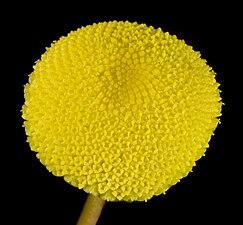| Cotula coronopifolia | |
|---|---|

| |
| 1796 illustration | |
| Scientific classification | |
| Kingdom: | Plantae |
| Clade: | Tracheophytes |
| Clade: | Angiosperms |
| Clade: | Eudicots |
| Clade: | Asterids |
| Order: | Asterales |
| Family: | Asteraceae |
| Genus: | Cotula |
| Species: | C. coronopifolia |
| Binomial name | |
| Cotula coronopifolia L. | |
| Synonyms | |
| |
Cotula coronopifolia is a species of flowering plant in the aster family (Asteraceae). Commonly known as brass buttons, golden buttons, and buttonweed, it is native to South Africa and New Zealand.
Description
The flower heads are bright yellow discoid heads that look like thick buttons. Individual plants spread stems along the ground and send up the knobby flowers at intervals. The plant is native to southern Africa, as well as New Zealand, but it has been introduced to other parts of the world (Europe, North + South America, etc.).
Brass buttons are common plants that occupy a specialized ecological niche. They prefer muddy, anoxic wetlands and brackish water. They are very salt-tolerant. The plant has fat, fleshy leaves that store water during times of saline inundation. The reddish stems and green, blade-shaped leaves are coated with a shiny cuticle to retain moisture. It can also be found in the wetter patches in vernal pool ecosystems. Brass buttons are common along beaches, salt marshes, and estuaries from California to Washington. It has been present in the British Isles since the late 1800s, especially on the Cheshire coast and is considered a neophyte naturalised plant.
Although brass buttons is known to be invasive, its spread appears to be relatively slow. Its California Invasive Plant Council Inventory rating is "limited", that is, "invasive but their ecological impacts are minor on a statewide level or there was not enough information to justify a higher score. Their reproductive biology and other attributes result in low to moderate rates of invasiveness. Ecological amplitude and distribution are generally limited, but these species may be locally persistent and problematic."
Gallery
-

-

-
Leaves sheath the stem and are entire or with a few teeth or deep lobes (Fir Island, Washington)
-

References
- Krähenfussblättrige Laugenblume, Cotula coronopifolia, Figure from Deutschlands Flora in Abbildungen, Author: Johann Georg Sturm, Painter: Jacob Sturm
- The Plant List, Cotula coronopifolia L.
- ^ Flora of North America, Brass-buttons, cotule, Cotula coronopifolia Linnaeus, Sp. Pl. 2: 892. 1753.
- Turner, B. L. 1996. The Comps of Mexico: A systematic account of the family Asteraceae, vol. 6. Tageteae and Athemideae. Phytologia Memoirs 10: i–ii, 1–22, 43–93.
- Welsh, S. L. 1974. Anderson's Flora of Alaska and Adjacent Parts of Canada i–xvi, 1–724. Brigham Young University Press, Provo
- Marticorena, C. & M. Quezada. 1985. Catálogo de la Flora Vascular de Chile. Gayana, Botánica 42: 1–157
- Gibbs Russell, G. E., W. G. M. Welman, E. Retief, K. L. Immelman, G. Germishuizen, B. J. Pienaar, M. Van Wyk & A. Nicholas. 1987. List of species of southern African plants. Memoirs of the Botanical Survey of South Africa 2(1–2): 1–152(pt. 1), 1–270(pt. 2).
- Altervista Flora Italiana, Margherita sudafricana, Cotula coronopifolia L. includes photos and European distribution map
- Stace, Clive (2019). New Flora of the British Isles (4th ed.). Middlewood Green, Suffolk: C & M Floristics. pp. 798–799. ISBN 9781527226302.
- Biota of North America Program 2014 county distribution map
- California Invasive Plant Council plant profile: Cotula coronopifolia (brassbuttons) Accessed Dec. 19, 2013
- California Invasive Plant Inventory Accessed Dec. 19, 2013
External links
- Jepson Manual Cotula coronopifolia
- Cotula coronopifolia occurrence data from GBIF
 Media related to Cotula coronopifolia at Wikimedia Commons
Media related to Cotula coronopifolia at Wikimedia Commons
| Taxon identifiers | |
|---|---|
| Cotula coronopifolia |
|